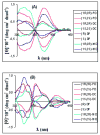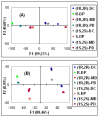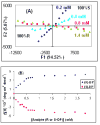Rapid enantiomeric excess and concentration determination using simple racemic metal complexes
- PMID: 18939802
- PMCID: PMC2749327
- DOI: 10.1021/ol802085j
Rapid enantiomeric excess and concentration determination using simple racemic metal complexes
Abstract
Racemic-metal complexes were used to determine identity, enantiomeric excess, and concentration of chiral diamines using metal-to-ligand charge transfer bands in circular dichroism spectroscopy. It takes under just 2 min per sample to determine [G]t and %R with tolerable errors (19% and 4%, respectively). The simplicity of the achiral receptors employed confers to this technique great potential for high-throughput screening.
Figures





Similar articles
-
Rapid determination of enantiomeric excess of α-chiral cyclohexanones using circular dichroism spectroscopy.Org Lett. 2011 May 6;13(9):2298-301. doi: 10.1021/ol2004885. Epub 2011 Apr 12. Org Lett. 2011. PMID: 21486023 Free PMC article.
-
High-throughput screening of identity, enantiomeric excess, and concentration using MLCT transitions in CD spectroscopy.J Am Chem Soc. 2008 Jul 23;130(29):9232-3. doi: 10.1021/ja803443j. Epub 2008 Jun 24. J Am Chem Soc. 2008. PMID: 18572934 Free PMC article.
-
Rapid optical methods for enantiomeric excess analysis: from enantioselective indicator displacement assays to exciton-coupled circular dichroism.Acc Chem Res. 2014 Jul 15;47(7):2212-21. doi: 10.1021/ar500147x. Epub 2014 Jun 3. Acc Chem Res. 2014. PMID: 24892802
-
Enantiomer-selective activation of racemic catalysts.Acc Chem Res. 2000 Jun;33(6):391-401. doi: 10.1021/ar9900818. Acc Chem Res. 2000. PMID: 10891057 Review.
-
Enantioseparation of organometallic compounds by electromigration techniques.Electrophoresis. 2024 Jun;45(11-12):1018-1032. doi: 10.1002/elps.202300231. Epub 2024 Jan 26. Electrophoresis. 2024. PMID: 38279597 Review.
Cited by
-
A facile circular dichroism protocol for rapid determination of enantiomeric excess and concentration of chiral primary amines.Chemistry. 2010 Jan 4;16(1):227-32. doi: 10.1002/chem.200902650. Chemistry. 2010. PMID: 19946914 Free PMC article.
-
Synthesis of Tripeptide Derivatives with Three Stereogenic Centers and Chiral Recognition Probed by Tetraaza Macrocyclic Chiral Solvating Agents Derived from d-Phenylalanine and (1 S,2 S)-(+)-1,2-Diaminocyclohexane via 1H NMR Spectroscopy.J Org Chem. 2018 Nov 16;83(22):13874-13887. doi: 10.1021/acs.joc.8b02212. Epub 2018 Oct 30. J Org Chem. 2018. PMID: 30346768 Free PMC article.
-
Chiroptical switches: applications in sensing and catalysis.Molecules. 2012 Jan 31;17(2):1247-77. doi: 10.3390/molecules17021247. Molecules. 2012. PMID: 22293845 Free PMC article. Review.
-
Rapid determination of enantiomeric excess of α-chiral cyclohexanones using circular dichroism spectroscopy.Org Lett. 2011 May 6;13(9):2298-301. doi: 10.1021/ol2004885. Epub 2011 Apr 12. Org Lett. 2011. PMID: 21486023 Free PMC article.
-
In situ assembly of octahedral Fe(II) complexes for the enantiomeric excess determination of chiral amines using circular dichroism spectroscopy.J Am Chem Soc. 2012 Mar 7;134(9):4398-407. doi: 10.1021/ja211768v. Epub 2012 Feb 22. J Am Chem Soc. 2012. PMID: 22272943 Free PMC article.
References
-
- Welch CJ, Szczerba T, Perrin SR. J Chromatogr A. 1997;758:93–98.
- Welch CJ, Grau B, Moore J, Mathre DJ. J Org Chem. 2001;66:6836–6837. - PubMed
- Welch CJ, Fleitz F, Antia F, Yehl P, Waters R, Ikemoto N, Armstrong IJD, Mathre DJ. Org Process Res Dev. 2004;8:186–191.
- Sigman MS, Jacobsen EN. J Am Chem Soc. 1998;120:4901–4902.
- Wolf C, Hawes PA. J Org Chem. 2002;67:2727–2729. - PubMed
-
-
For recently publications see: Bailey DM, Hennig A, Uzunova VD, Nau WM. Chem Eur J. 2008;14:6069–6077.Truppo MD, Escalettes F, Turner NJ. Angew Chem Int Ed. 2008;47:2639–2641.Chen Z-H, He Y-B, Hu C-G, Huang X-H, Hu L. Aust J Chem. 2008;61:310–315.Ingle JR, Busch KW, Kenneth W, Busch MA. Talanta. 2008;75:572–584.Tanaka H, Matilde S. Chirality. 2008;20:307–312.Yashima E, Katsuhiro M. Macromolecules. 2008;41:3–12.Young BL, Cooks RG. Int J Mass Spectrom. 2007;267:199–204.Li Z-B, Lin J, Sabat M, Hyacinth M, Pu L. J Org Chem. 2007;72:4905–4916.
-
-
- Lin J, Zhang HC, Pu L. Org Lett. 2002;4:3297–3300. - PubMed
- Lee SJ, Lin W. J Am Chem Soc. 2002;124:4554–4555. - PubMed
- Ahn KH, Ku H-Y, Kim Y, Kim S-G, Kim YK, Son HS, Ku JK. Org Lett. 2003;5:1419–1422. - PubMed
- Corradini R, Paganuzzi C, Marchelli R, Pagliari S, Sforza S, Dossena A, Galaverna G, Duchateau J Mater Chem. 2005;15:2741–2746. - PubMed
-
- Zhu L, Anslyn EV. J Am Chem Soc. 2004;126:3676–3677. - PubMed
- Folmer-Andersen JF, Lynch VM, Anslyn EV. J Am Chem Soc. 2005;127:7986–7987. - PubMed
- Zhu L, Zhong Z, Anslyn EV. J Am Chem Soc. 2005;127:4260–4269. - PubMed
- Zhu L, Shabbir SH, Anslyn EV. Chem Eur J. 2006;13:99–104. - PubMed
- Folmer-Andersen JF, Kitamura M, Anslyn EV. J Am Chem Soc. 2006;128:5652–5653. - PubMed
Publication types
MeSH terms
Substances
Grants and funding
LinkOut - more resources
Full Text Sources
Other Literature Sources

